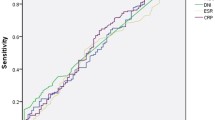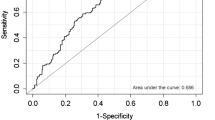Abstract
Introduction
We evaluated different factors predicting the development of acute pyelonephritis in Iranian children, with special attention to time factor.
Methods
One hundred nineteen patients (93 females and 26 males; age = 32.6 ± 30.8 months) with first urinary tract infection (UTI) were evaluated. None had previous urological problems. Prior to antibiotic therapy blood samples were gathered for laboratory evaluation. Vital signs on admission were measured. Clinical and laboratory indices, including therapeutic delay time (TDT) and therapeutic response time (TRT), were measured. Most patients were evaluated with renal ultrasound in the first three days following admission. All patients underwent dimercaptosuccinic acid (DMSA) renal scintigraphy and 71 were assessed for vesicoureteral reflux (VUR).
Results
DMSA scans were abnormal in 77 cases, of which 11 cases had bilateral renal involvement. Mean values for TDT, TRT, leukocyte count (LC), absolute neutrophil count (ANC), erythrocyte sedimentation rate (ESR), and C-reactive protein (CRP) were 74.1 h, 39.6 h, 15725 ± 6682 mm−3, 10772 ± 6458 mm−3, 51.9 ± 32.5 mm, and 27.3 ± 25.1 mg l−1, respectively. VUR was present in 29 of 142 evaluated renal units.
Conclusion
TDT ≥ 48 h, TRT ≥ 24 h, axillary temperature ≥ 39°C, LC ≥ 13500 mm−3, and age ≥ 18 months predicted abnormal DMSA scan in patients with first episode of UTI. Considerably higher TDT and TRT values of the current study compared to previous ones suggests the more important role of time factor in predicting abnormal DMSA findings in a developing country than in developed ones.
Similar content being viewed by others
References
Islekel H, Soylu A, Altun Z, Yis U, Turkmen M, Kavukcu S (2007) Serum and urine cystatin C levels in children with post-pyelonephritic renal scarring: a pilot study. Int Urol Nephrol 39:1241–1250
Sheu JN, Chen MC, Cheng SL, Lee IC, Chen SM, Tsay GJ (2007) Urine interleukin-1beta in children with acute pyelonephritis and renal scarring. Nephrology (Carlton) 12:487–493
Rushton HG (1997) The evaluation of acute pyelonephritis and renal scarring with technetium 99m-dimercaptosuccinic acid renal scintigraphy: evolving concepts and future directions. Pediatr Nephrol 11:108–120
American Academy of Pediatrics. Committee on Quality Improvement. Subcommittee on Urinary Tract Infection (1999) Practice parameter: the diagnosis, treatment, and evaluation of the initial urinary tract infection in febrile infants and young children. Pediatrics 103:843–852
Fernández-Menéndez JM, Málaga S, Matesanz JL, Solís G, Alonso S, Pérez-Méndez C (2003) Risk factors in the development of early technetium-99m dimercaptosuccinic acid renal scintigraphy lesions during first urinary tract infection in children. Acta Paediatr 92:21–26
Peru H, Bakkaloglu SA, Soylemezoglu O, Buyan N, Hasanoglu E (2008) The relationship between urinary tract infections and vesicoureteral reflux in Turkish children. Int Urol Nephrol Aug 8 (Epub ahead of print)
Lavocat MP, Granjon D, Allard D, Gay C, Freycon MT, Dubois F (1997) Imaging of pyelonephritis. Pediatr Radiol 27:159–165
Hansson S, Bollgren I, Esbjörner E, Jakobsson B, Mårild S (1999) Urinary tract infections in children below two years of age: a quality assurance project in Sweden. Acta Paediatr 88:270–274
Hoberman A, Wald ER, Hickey RW, Baskin M, Charron M, Majd M, Kearney DH, Reynolds EA, Ruley J, Janosky JE (1999) Oral versus initial intravenous therapy for urinary tract infections in young febrile children. Pediatrics 104:79–86
EANM Pediatric Task Group (1990) A radiopharmaceuticals schedule for imaging in pediatrics. Eur J Nucl Med 17:127–129
Lebowitz RL, Olbing H, Parkkulainen KV, Smellie JM, Tamminen-Möbius TE (1985) International system of radiographic grading of vesicoureteric reflux. International Reflux Study in Children. Pediatr Radiol 15:105–109
Rosenberg AR, Rossleigh MA, Brydon MP, Bass SJ, Leighton DM, Farnsworth RH (1992) Evaluation of acute urinary tract infection in children by dimercaptosuccinic acid scintigraphy: a prospective study. J Urol 148(5 Pt 2):1746–1749
Björgvinsson E, Majd M, Eggli KD (1991) Diagnosis of acute pyelonephritis in children: comparison of sonography and 99mTc-DMSA scintigraphy. AJR Am J Roentgenol 157(3):539–543
Martin Aguado MJ, Canals Baeza A, Vioque Lopez J, Tarazona JL, Flores Serrano J (2000) Technetium-99m-dimercaptosuccinic acid (DMSA) scintigraphy in the first febrile urinary tract infection in children. An Esp Pediatr 52(1):23–30
Goldman M, Bistritzer T, Horne T, Zoareft I, Aladjem M (2000) The etiology of renal scars in infant with pyelonephritis and vesico-ureteral reflux. Pediatr Nephrol 14(5):385–388
Fretzayas A, Moustaki M, Gourgiotis D, Bossios A, Koukoutsakis P, Stavrinadis C (2000) Polymorphonuclear elastase as a diagnostic marker of acute pyelonephritis in children. Pediatrics 105(2):E28
Krzemien G, Roszkowska-Blaim M, Kostro I, Szmigielska A, Karpinska M, Sieniawska M, Bartlomiejczyk I, Paczek L, Toth K (2004) Urinary levels of interleukin-6 and interleukin-8 in children with urinary tract infections to age 2. Med Sci Monit 10(11):CR593–CR597
Biggi A, Dardanelli L, Pomero G, Cussino P, Noello C, Sernia O, Spada A, Camuzzini G (2001) Acute renal cortical scintigraphy in children with a first urinary tract infection. Pediatr Nephrol 16(9):733–738
Kotoula A, Gardikis S, Tsalkidis A, Mantadakis E, Zissimopoulos A, Kambouri K, Deftereos S, Tripsianis G, Manolas K, Chatzimichael A, Vaos G (2009) Procalcitonin for the early prediction of renal parenchymal involvement in children with UTI: preliminary results. Int Urol Nephrol 41(2):393–399
Soylu A, Demir BK, Türkmen M, Bekem O, Saygi M, Cakmakçi H, Kavukçu S (2008) Predictors of renal scar in children with urinary infection and vesicoureteral reflux. Pediatr Nephrol 23(12):2227–2232
Mena E, Díaz C, Bernà LL, Martín-Miramón JC, Durán C, Cristóbal Rojo J (2006) Evaluation of renal lesions using 99mTc-DMSA in children with urinary tract infection and the relation with vesicoureteral reflux. Rev Esp Med Nucl 25(6):374–379
Moorthy I, Easty M, McHugh K, Ridout D, Biassoni L, Gordon I (2005) The presence of vesicoureteric reflux does not identify a population at risk for renal scarring following a first urinary tract infection. Arch Dis Child 90(7):733–736
Wheeler D, Vimalachandra D, Hodson EM et al (2003) Antibiotics and surgery for vesicoureteric reflux: a meta-analysis of randomised controlled trials. Arch Dis Child 88:688–694
Acknowledgments
This work was performed at the Children’s Hospital Medical Center. This research was supported by the research council of Tehran University of Medical Sciences. The authors thank Mr. Mohajer and Mrs. Ildoromi for their technical assistance.
Author information
Authors and Affiliations
Corresponding author
Rights and permissions
About this article
Cite this article
Ansari Gilani, K., Modaresi Esfeh, J., Gholamrezanezhad, A. et al. Predictors of abnormal renal cortical scintigraphy in children with first urinary tract infection: the importance of time factor. Int Urol Nephrol 42, 1041–1047 (2010). https://doi.org/10.1007/s11255-009-9650-x
Received:
Accepted:
Published:
Issue Date:
DOI: https://doi.org/10.1007/s11255-009-9650-x




